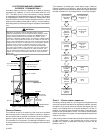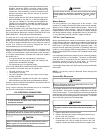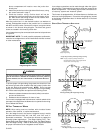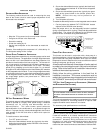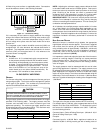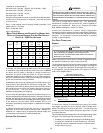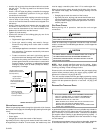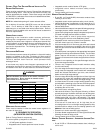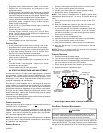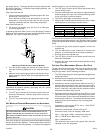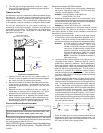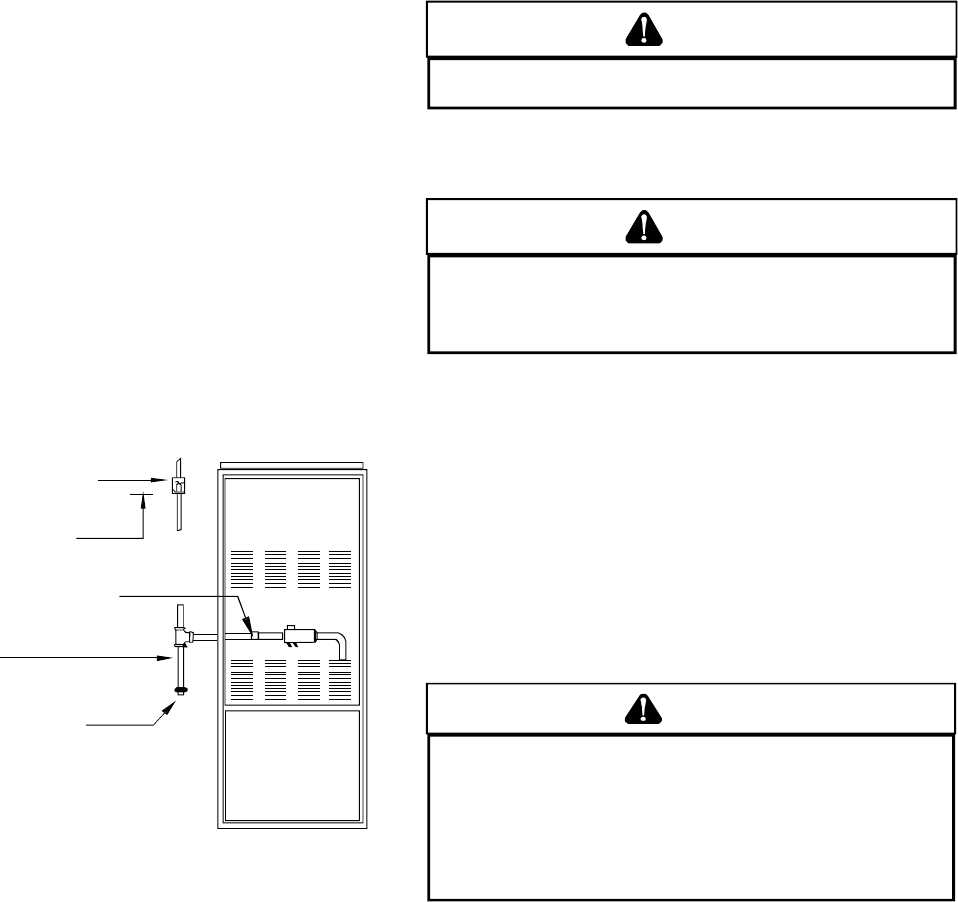
19
IO-247A 12/04
• Install a drip leg to trap dirt and moisture before it can enter
the gas valve. The drip leg must be a minimum of three
inches long.
• Install a 1/8" NPT pipe plug fitting, accessible for test gage
connection, immediately upstream of the gas supply
connection to the furnace.
• Use two pipe wrenches when making connection to the gas
valve to keep it from turning. The orientation of the gas
valve on the manifold must be maintained as shipped from
the factory.
• Install a manual shutoff valve between the gas meter and
unit within six feet of the unit. If a union is installed, the
union must be downstream of the manual shutoff valve,
between the shutoff valve and the furnace.
• Tighten all joints securely.
• Connect the furnace to the building piping by one of the
following methods:
– Rigid metallic pipe and fittings.
– Semi-rigid metallic tubing and metallic fittings.
Aluminum alloy tubing must not be used in exterior
locations.
– Use listed gas appliance connectors in accordance with
their instructions. Connectors must be fully in the same
room as the furnace.
– Protect connectors and semi-rigid tubing against
physical and thermal damage when installed. Ensure
aluminum-alloy tubing and connectors are coated to
protect against external corrosion when in contact with
masonry, plaster, or insulation, or subjected to repeated
wetting by liquids such as water (except rain water),
detergents, or sewage.
``
Location of Manual Valve
(Installed Ahead of Ground
J
oint Pipe Union)
Height Required
By Local Code
Ground Joint Pipe Union
To Be Installed Ahead Of
Gas Valve
Drip Leg
Reducing Coupling
1/2" x 1/8" with 1/8"
Pipe Plug To Measure
Line Gas Pressure
General Furnace Layout
UPFLOW INSTALLATIONS
When the gas piping enters through the right side of the furnace,
the installer must supply the following fittings (starting from the gas
valve):
• 90 degree elbows (2).
• Close nipple.
• Straight pipe to reach the exterior of the furnace .
A ground joint union, drip leg, and manual shutoff valve must also
be supplied by the installer. In some cases, the installer may also
need to supply a transition piece from 1/2" to another pipe size.
When the gas piping enters through the left side of the furnace,
the installer must supply the following fittings (starting from the
gas valve):
• Straight pipe to reach the exterior of the furnace.
• A ground joint union, drip leg, and manual shutoff valve must
also be supplied by the installer. In some cases, the installer
may also need to supply a transition piece from 1/2 inch to
another pipe size.
GAS PIPING CHECKS
Before placing unit in operation, leak test the unit and gas
connections.
WARNING
T
O AVOID THE POSSIBILITY OF EXPLOSION OR FIRE, NEVER USE A MATCH OR
OPEN FLAME TO TEST FOR LEAKS.
Check for leaks using an approved chloride-free soap and water
solution, an electronic combustible gas detector, or other approved
testing methods.
CAUTION
T
O PREVENT PROPERTY DAMAGE OR PERSONAL INJURY DUE TO FIRE, THE
FOLLOWING INSTRUCTIONS MUST BE PERFORMED REGARDING GAS
CONNECTIONS, PRESSURE TESTING, LOCATION OF SHUTOFF VALVE AND
INSTALLATION OF GAS PIPING.
NOTE: Never exceed specified pressures for testing. Higher
pressure may damage the gas valve and cause subsequent
overfiring, resulting in heat exchanger failure.
Disconnect this unit and shutoff valve from the gas supply piping
system before pressure testing the supply piping system with
pressures in excess of 1/2 psig (3.48 kPa).
This unit must be isolated from the gas supply system by closing
its manual shutoff valve before pressure testing of gas supply piping
system with test pressures equal to or less than 1/2 psig (3.48
kPa).
PROPANE GAS TANKS AND PIPING
WARNING
IF THE GAS FURNACE IS INSTALLED IN A BASEMENT, AN EXCAVATED
AREA OR A CONFINED SPACE, IT IS STRONGLY RECOMMENDED TO
CONTACT A PROPANE SUPPLIER TO INSTALL A GAS DETECTING
WARNING DEVICE IN CASE OF A GAS LEAK.
•
S
INCE PROPANE GAS IS HEAVIER THAN AIR, ANY LEAKING GAS CAN
SETTLE IN ANY LOW AREAS OR CONFINED SPACES.
•
P
ROPANE GAS ODORANT MAY FADE, MAKING THE GAS UNDETECTABLE
EXCEPT WITH A WARNING DEVICE.
A gas detecting warning system is the only reliable way to detect a
propane gas leak. Rust can reduce the level of odorant in propane
gas. Do not rely on your sense of smell. Contact a local propane
gas supplier about installing a gas detecting warning system. If
the presence of gas is suspected, follow the instructions on Page
4 of this manual.
All propane gas equipment must conform to the safety standards
of the National Board of Fire Underwriters, NBFU Manual 58.



